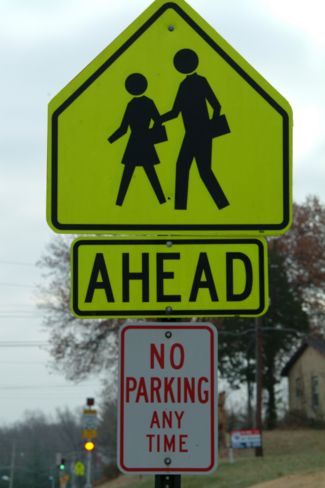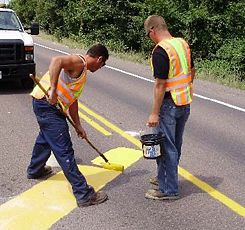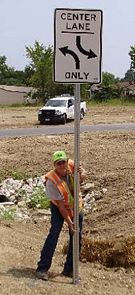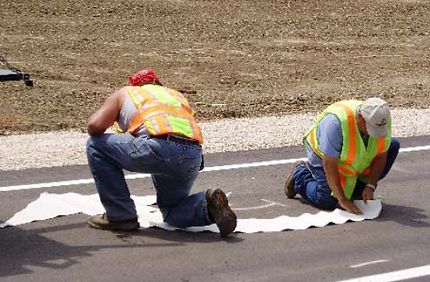Difference between revisions of "903.18 Signing for School Areas"
m (→903.16.3 School Crossing Control Criteria (MUTCD Section 7A.03): article construction) |
m (→Table 903.16.5.4 School Sign Sizes: re-linked article to RSMo Sec 304.050) |
||
| Line 168: | Line 168: | ||
'''Guidance.''' The SCHOOL BUS STOP AHEAD (S3-1) sign should be installed in advance of locations where a school bus, when stopped to pick up or discharge passengers, is not visible to travelers for a the minimum distance shown in Table 903.16.5.10 in advance and where there is no opportunity to relocate the bus stop to provide the minimum feet of visibility. | '''Guidance.''' The SCHOOL BUS STOP AHEAD (S3-1) sign should be installed in advance of locations where a school bus, when stopped to pick up or discharge passengers, is not visible to travelers for a the minimum distance shown in Table 903.16.5.10 in advance and where there is no opportunity to relocate the bus stop to provide the minimum feet of visibility. | ||
| − | '''Support.''' [http://www.moga | + | '''Support.''' [http://www.moga.mo.gov/statutes/C300-399/3040000050.HTM Section 304.050, RSMo], paragraph 4, defines, by state statute the minimum allowable sight distance a school bus stop must have. The statute says “…nor shall any passengers be taken on or discharged while the vehicle is upon the road or highway proper unless the vehicle so stopped is plainly visible for at least five hundred feet in each direction to drivers of other vehicles in the case of a highway with no shoulder and a speed limit greater than 60 miles per hour and at least three hundred feet in each direction to drivers of other vehicles upon other highways”. While shoulder is not defined in state statutes, for this purpose it will mean a shoulder of sufficient width and strength for a school bus to be able to safely and completely leave the traveled portion of the roadway. At those locations not meeting the requirements above, a school bus stop is not allowed. |
It is not intended that these signs be used everywhere a school bus stops to pick up or discharge passengers, but for use where terrain and roadway features limit the approach sight distance and where there is no opportunity to relocate the stop to another location with adequate sight distance. | It is not intended that these signs be used everywhere a school bus stops to pick up or discharge passengers, but for use where terrain and roadway features limit the approach sight distance and where there is no opportunity to relocate the stop to another location with adequate sight distance. | ||
Revision as of 07:55, 28 August 2009
Contents
- 1 903.16.1 Need for Standards (MUTCD Section 7A.01)
- 2 903.16.2 School Routes and Established School Crossings (MUTCD Section 7A.02)
- 3 903.16.3 School Crossing Control Criteria (MUTCD Section 7A.03)
- 4 903.16.4 Scope (MUTCD Section 7A.04 through 7A.10)
- 5 903.16.5 School Signs (MUTCD Section 7B)
- 6 903.16.6 School Speed Limits
903.16.1 Need for Standards (MUTCD Section 7A.01)
Support. Regardless of the school location, the best way to achieve reasonably safe and effective traffic control is through the uniform application of realistic policies, practices and standards developed through engineering judgment.
Pedestrian safety depends upon public understanding of accepted methods for efficient traffic control. This principle is especially important in the control of pedestrians, bicycles, and other vehicles in the vicinity of schools. Neither pedestrians on their way to or from school nor road users can be expected to move safely in school areas unless they understand both the need for traffic controls and how these controls function for their benefit.
Procedures and devices that are not uniform might cause confusion among pedestrians and road users, prompt wrong decisions, and contribute to crashes. To achieve uniformity of traffic control in school areas, comparable traffic situations need to be treated in a consistent manner. Each traffic control device and control method described in Traffic Controls for School Areas fulfills a specific function related to specific traffic conditions.
A uniform approach to school area traffic controls assures the use of similar controls for similar situations (which promotes uniform behavior on the part of motorists, pedestrians and bicyclists).
A school traffic control plan permits the orderly review of school area traffic control needs and the coordination of school/pedestrian safety education and engineering activities.
Guidance. The type(s) of school area traffic control devices used, either warning or regulatory, should be related to the volume and speed of vehicular traffic, street width and the number and age of the students.
903.16.2 School Routes and Established School Crossings (MUTCD Section 7A.02)
Support. Not applicable to MoDOT.
903.16.3 School Crossing Control Criteria (MUTCD Section 7A.03)
| Finishing Touches for a New School's Turn Lane in Lincoln County | |
Support. Not applicable to MoDOT.
903.16.4 Scope (MUTCD Section 7A.04 through 7A.10)
Standard. This article sets forth basic principles and prescribes standards that shall be followed in the design, application, installation and maintenance of all traffic control devices (including signs, signals and markings) and other controls (including adult crossing guards, student patrols and grade-separated crossings) required for the special pedestrian conditions in school areas.
Option. In-roadway signs for school traffic control areas may be used consistent with the requirements of 903.5.7, 903.16.5.8 and 903.16.5.9.
Support. Requirements discussed in 903.1 and 903.5.4.1, Stop Sign Applications are applicable in school areas.
Refer to 903.19.2, 903.19.3, 903.19.6, 903.19.8 and 903.19.9 for additional information about the purpose of traffic control devices, principles of traffic control devices, maintenance of traffic control devices, authority for placement of traffic control devices and engineering study and engineering judgment, respectively.
903.16.5 School Signs (MUTCD Section 7B)
903.16.5.1 Size of School Signs. (MUTCD Section 7B.01)
Standard. The sizes of signs and plaques to be used on conventional roadways in school areas shall be as shown in Table 903.16.5.4.
The Conventional Road sign size shall be used on public roads, streets, and highways unless engineering judgment determines that a Minimum or Oversized sign size would be more appropriate.
The Oversized sign size shall be used on expressways.
Option. The Oversized sign size may be used for applications that require increased emphasis, improved recognition, or increased legibility. The minimum sign size may be used on local residential streets, in urban areas, and where there are low traffic volumes and low vehicle speeds, as determined by engineering judgment.
903.16.5.2 Illumination and Reflectorization. (MUTCD Section 7B.02)
Standard. The signs used for school area traffic control shall be retroreflectorized.
903.16.5.3 Position of Signs. (MUTCD Section 7B.03)
Guidance. Signs should be placed in positions where they will convey their messages most effectively without restricting lateral clearance or sight distances. Placement therefore should consider highway design, alignment, vehicle speed and roadside development.
Signs should have a maximum practical clearance from the edge of the travelway for the safety of vehicles that might leave the roadway and strike the sign supports. Except as noted in paragraph below, signs are not to be closer than 6 ft. from the edge of a paved shoulder, or if none, 12 ft. from the edge of the travelway.
Option. In urban areas, a lesser clearance of not less than 2 ft. from the face of the curb may be used. In urban areas, where sidewalk width is limited or existing poles are close to the curb, a clearance of 1 ft. from the curb face may be used.
903.16.5.4 Height of Signs. (MUTCD Section 7B.04)
Support. 903.3.3 contains information regarding the mounting height of signs.
Table 903.16.5.4 School Sign Sizes
| Sign | Sign Number | Article | Conventional | Expressway (At Grade) | Freeway (Grade Separated) | Other |
|---|---|---|---|---|---|---|
| SCHOOL ADVANCE | S1-1 | 903.16.5.8 | 36 x 36 | - | - | - |
| SCHOOL ADVANCE (FLUORESCENT YELLOW GREEN) | S1-1(fyg) | 903.16.5.8 | 36 x 36 | - | - | - |
| AHEAD | W16-9P | 903.16.5.8 | 36 x 12 | - | - | - |
| AHEAD (FLUORESCENT YELLOW GREEN) | W16-9P(fyg) | 903.16.5.8 | 36 x 12 | - | - | - |
| DIAGONAL ARROW PLAQUE | W16-7P | 903.16.5.9 | 30 x 18 | - | - | - |
| DIAGONAL ARROW PLAQUE (FLUORESCENT YELLOW GREEN) | W16-7P(fyg) | 903.16.5.09 | 30 x 18 | - | - | - |
| SCHOOL BUS STOP AHEAD | S3-1 | 903.16.5.10 | 36 x 36 | - | - | - |
| SCHOOL | S4-3 | 903.16.5.11 | 30 x 12 | - | - | - |
| SCHOOL (FLUORESCENT YELLOW GREEN) | S4-3 | 903.16.5.11 | 30 x 12 | - | - | - |
| WHEN FLASHING | S4-4 | 903.16.5.11 | 30 x 12 | - | - | - |
903.16.5.5 Installation of Signs. (MUTCD Section 7B.05)
Support. 903.1.19 contains information regarding the installation of signs.
903.16.5.6 Lettering. (MUTCD Section 7B.06)
Support. The Federal Highway Administration’s Standard Highway Signs (see 903.19.11) contains information regarding sign lettering.
903.16.5.7 Sign Color for School Warning Signs. (MUTCD Section 7B.07)
Standard. Except as noted in the two paragraphs below, school warning signs shall have a yellow background with a black legend and border unless otherwise stated in this article for a specific sign.
Option. MoDOT will allow the fluorescent yellow-green background on the School Advance Warning assembly and the School Crossing Warning assembly when there has been a request from the community for this sign color. This request may be considered in order to provide consistency within a community. MoDOT signs may be changed while the community is replacing all existing School Advance Warning and School Crossing Warning assemblies on their systems. Where the only assemblies in the community are on the state system, our existing signs may be replaced at the discretion of the district after a request has been received.
The following school warning signs may have a fluorescent yellow-green background with a black legend and border:
A. School Advance Warning sign (S1-1);
B. AHEAD plaque (W16-9p);
C. Diagonal Arrow plaque (W16-7p); and
D. School (S4-3);
Guidance. When the fluorescent yellow-green background color is used, a systematic approach featuring one background color within a zone or area should be used. The mixing of standard yellow and fluorescent yellow-green backgrounds within a zone or area should be avoided.
Support. As a community partner, MoDOT will pay for the cost of the signs on the state system.
903.16.5.8 School Advance Warning Assembly (S1-1, S1-1fyg, with Supplemental Plaque). (MUTCD Section 7B.08)
Standard. The School Advance Warning assembly should be installed in advance of locations where school buildings or grounds are adjacent to the highway, except where a physical barrier such as fencing separates school children from the highway.
The School Advance Warning assembly shall be used in advance of any installation of the School Crosswalk Warning assembly (see Figure 903.16.5.9.1), or in advance of the first installation of the School Speed Limit assembly (see Figure 7B-3).
If used, the School Advance Warning assembly shall be installed not less than 150 ft. nor more than 700 ft. in advance of the school grounds or school crossings.
If used, the School Advance Warning assembly shall consist of a School Advance Warning (S1-1, S1-1fyg) sign supplemented with a plaque with the legend AHEAD (W16-9p, W16-9pfyg) to provide advance notice to road users of crossing activity.
903.16.5.9 School Crosswalk Warning Assembly (S1-1, S1-1fyg, with Diagonal Arrow) (MUTCD Section 7B.09)
Standard. If used, the School Crosswalk Warning assembly shall be installed at the marked crosswalk, or as close to it as possible, and shall consist of a School Advance Warning (S1-1, S1-1fyg) sign supplemented with a diagonal downward pointing arrow (W16-7p, W16-7pfyg) plaque to show the location of the crossing.
The School Crosswalk Warning assembly shall not be used at marked crosswalks other than those adjacent to schools and those on established school pedestrian routes.
| School Crosswalk Warning Assembly Figures |
| Example of Signing for School Crosswalk Warning Assembly |
| Example of Signing for School Area Traffic Control with School Speed Limits |
The School Crosswalk Warning assembly shall not be installed on approaches controlled by a STOP sign.
A school-crossing contract shall be required prior to the installation of these signs. All requests shall be reviewed in the district.
A competent adult crossing guard acting for the School District shall supervise the operation of the crosswalk and the crossing of the students during hours of operation.
Guidance. The School Crosswalk Warning assembly should be installed at marked crosswalk(s) used by students going to and from school with the exceptions of crossings controlled by permanent signal installations. At permanent signal installation locations, the School Crossing Warning assembly should be omitted.
Support. The school-crossing contract can be found on the Chief Counsel’s Office Intranet site. The district engineer is authorized to sign all contracts for signs at school crossings.
903.16.5.10 SCHOOL BUS STOP AHEAD Sign (S3-1). (MUTCD Section 7B.10)
Guidance. The SCHOOL BUS STOP AHEAD (S3-1) sign should be installed in advance of locations where a school bus, when stopped to pick up or discharge passengers, is not visible to travelers for a the minimum distance shown in Table 903.16.5.10 in advance and where there is no opportunity to relocate the bus stop to provide the minimum feet of visibility.
Support. Section 304.050, RSMo, paragraph 4, defines, by state statute the minimum allowable sight distance a school bus stop must have. The statute says “…nor shall any passengers be taken on or discharged while the vehicle is upon the road or highway proper unless the vehicle so stopped is plainly visible for at least five hundred feet in each direction to drivers of other vehicles in the case of a highway with no shoulder and a speed limit greater than 60 miles per hour and at least three hundred feet in each direction to drivers of other vehicles upon other highways”. While shoulder is not defined in state statutes, for this purpose it will mean a shoulder of sufficient width and strength for a school bus to be able to safely and completely leave the traveled portion of the roadway. At those locations not meeting the requirements above, a school bus stop is not allowed.
It is not intended that these signs be used everywhere a school bus stops to pick up or discharge passengers, but for use where terrain and roadway features limit the approach sight distance and where there is no opportunity to relocate the stop to another location with adequate sight distance.
Standard. The requirements to use the SCHOOL BUS STOP AHEAD signs are:
A. For this policy, the school bus stop shall be defined as the location where passengers wait to be picked up or are discharged.
B. The sight distance shall be determined using a 3.5 ft. eye height and a 4.25 ft. object height.
C. Each approach to the school bus stop shall be considered independently of each other, i.e. it may not be necessary to sign both approaches to the school bus stop.
The location of school bus stops may change from year to year. It is therefore, imperative the district keep track of all School Bus Stop Ahead signs. The school districts shall provide confirmation to the district office when the school bus stops are active. This shall be done prior to the fall session. Also, whenever the school districts are aware of a school bus stop location change, they shall advise the district office as soon as possible.
Option. If a location has more than the minimum sight distance required by statute, as described above, but less than the values in Table 903.16.5.10, placement of the SCHOOL BUS STOP AHEAD sign may be allowed.
Table 903.16.5.10 Sight Distance Requirements (for use of S3-1 sign)
| Posted Speed (mph) | Minimum Sight Distance (ft.) | Maximum Sight Distance (ft.) |
|---|---|---|
| 30 | 300 | 500 |
| 35 | 300 | 500 |
| 40 | 300 | 500 |
| 45 | 300 | 500 |
| 50 | 300 | 510 |
| 55 | 300 | 560 |
| 60 | 500 | 625 |
| 65 | 500 | 700 |
| 70 | 500 | 740 |
903.16.5.11 School Speed Limit Flasher Assembly (S4-1, S4-3, S4-4) (MUTCD Section 7B.11)
Standard. A School Speed Limit Flasher assembly (see Figure 903.16.5.9.2) shall be used to indicate the speed limit where a reduced speed zone for a school area has been established (in accordance with law based upon an engineering study) or where a speed limit is specified for such areas by statute. The School Speed Limit Flasher assembly shall be placed at or as near as practical to the point where the reduced speed zone begins.
Guidance. The reduced speed zone should begin either at a point 200 ft. from the crosswalk, or at a point 100 ft. from the school property line, based on whichever is encountered first as traffic approaches the school.
If a school speed limit flasher is installed, no other school flasher should be permitted.
Standard. The fixed-message School Speed Limit assembly shall consist of a top plaque (S4-3) with the legend SCHOOL, a Speed Limit (R2-1) sign, and a bottom plaque (S4-1, S4-4) with the legend ?:?? A.M. TO ?:?? P.M. or WHEN FLASHING.
School speed limits are in effect only when the flasher is operational.
903.16.5.12 Reduced speed School Zone Ahead Sign (S4-5, S4-5a). (MUTCD Section 7B.012)
Support. Not used in Missouri.
903.16.5.13 End School Zone Speed Limit Sign (S5-2). (MUTCD Section 7B.13)
Standard. The end of an authorized and posted school speed zone shall be marked with a standard Speed Limit sign showing the speed limit for the section of highway that follows.
903.16.5.14 Parking and Stopping Signs (R7 and R8 Series). (MUTCD Section 7B.14)
Option. Parking and stopping regulatory signs may be used to prevent parked or waiting vehicles from blocking pedestrians’ views, and drivers’ views of pedestrians and to control vehicles as a part of the school traffic plan.
Support. 903.5.35 and 903.5.36 contain information regarding the signing of parking regulations in school zone areas.
903.16.6 School Speed Limits
Upon receipt of a school speed limit request, the district shall perform a speed study and site investigation. The school speed limit shall be 10 mph below either the posted speed limit or the 85th percentile speed, whichever is higher, as determined by the speed study. In no case will a school speed limit of less than 25 mph be allowed. Also see 902.4 Flashers and Signals for Schools and Other Special Applications.




